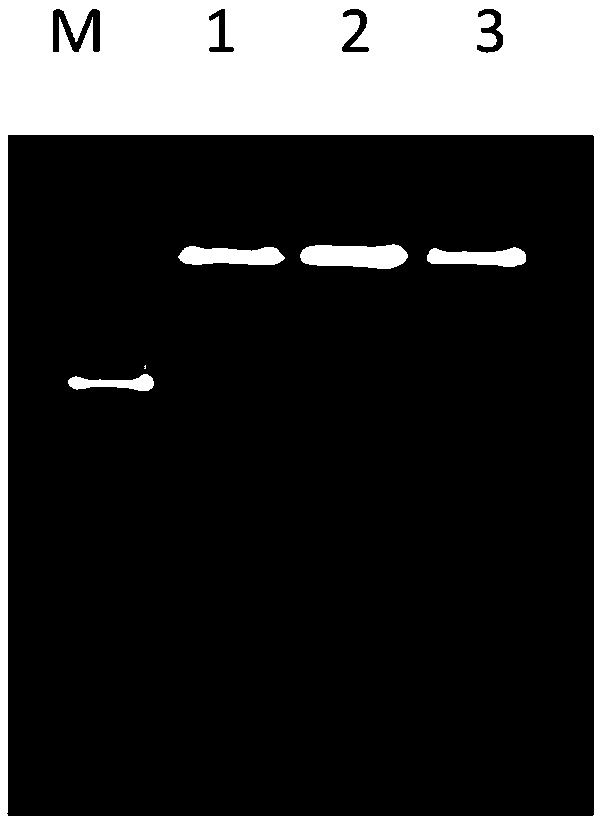Gene NtTPKa capable of increasing tobacco leaf potassium content and cloning method and application of gene NtTPKa
A cloning method, technology of potassium content, applied in the field of genetic engineering, can solve the problem of high rate
- Summary
- Abstract
- Description
- Claims
- Application Information
AI Technical Summary
Problems solved by technology
Method used
Image
Examples
Embodiment 1
[0067] Genes that Increase Potassium Content in Tobacco Leaves NtTPKa clone
[0068] A. OK NtTPKa gene sequence;
[0069] under rice AtTPK1 Homologous genes in tobacco were obtained by searching the NCBI database for the protein sequence of the gene NtTPKa Sequence, use this sequence to design gene cloning primers:
[0070] Forward primer: NtTPKaF: ATGGATAAAGGTGATGTTGAAC
[0071] Reverse primer: NtTPKaR: TCAGATTTTCGATCGAGACGA
[0072] B. extract tobacco leaf tissue RNA, and reverse transcribe to obtain the first-strand cDNA;
[0073] C. Using the first-strand cDNA obtained by reverse transcription as a template, perform PCR amplification with primers NtTPKaF / NtTPKaR, recover and purify the PCR product;
[0074] D. Ligate the purified product with the carrier. The ligation system and process are as follows: 4 μL of the purified product, 1 μL of salt solution, 1 μL of PCR®-BluntⅡ-TOPO (Invitrogen) and mix well, at 25°C, in a water bath for 30 minutes; transform the ligat...
Embodiment 2
[0078] tobacco potassium transporter gene NtTPKa Obtaining of RNAi transgenic plants
[0079] A. RNAi vector construction:
[0080] a. Construction of PCR®-BluntII-TOPO vector as intermediate vector and pK7GW1WG2 as expression vector backbone NtTPKa Gene RNAi vector, construct primers as follows:
[0081] TPKa-KD-F: 5'- GGATCC GGCATGGCTCTTGTTGGATT-3'
[0082] TPKa-KD-R: 5'- CTCGAG GTCGAAAAGCTCTTATCGCCA-3'
[0083] GGTACC in TPKa-KD-F is the BamHI I restriction site, and CTCGAG in TPKa-KD-R is the Xho I restriction site;
[0084] b. to contain NtTPKa The TOPO plasmid DNA of the positive clone was used as a template for PCR amplification. The PCR reaction volume was 50 μL, including: 200ng DNA, 10 μL of 5×Phusion HF reaction buffer, 1 μL of 10mM dNTP, 2U of Phusion® High-Fidelity DNA Polymerase, and 10 μM of TPKa -KD-F primers, TPKa-KD-R primers 1 μL each, add water to 50 μL. The PCR reaction was carried out on a Mastercycler® pro amplification instrument, and the re...
Embodiment 3
[0107] Detection of Potassium Content in NtTPKa RNAi Transgenic Lines of Tobacco
[0108] The T1 generation of transgenic lines TPK-KD-6, TPK-KD-19 with significantly reduced expression of the target gene and the empty vector control VC were planted in potted plants in the greenhouse ( Figure 5 ). Use tobacco-specific compound fertilizer (nitrogen: phosphorus: potassium = 10:10:15) according to 5g of pure nitrogen per plant, and apply it in 5 times. Take the middle leaves (9-12 leaves) at the budding stage, and test the potassium content after killing, the results are shown in Figure 6 , the potassium content of the transgenic lines increased by more than 20% compared with the control. show that by inhibiting NtTPKa Tobacco leaves with increased potassium content can be obtained by gene expression.
PUM
 Login to View More
Login to View More Abstract
Description
Claims
Application Information
 Login to View More
Login to View More - R&D
- Intellectual Property
- Life Sciences
- Materials
- Tech Scout
- Unparalleled Data Quality
- Higher Quality Content
- 60% Fewer Hallucinations
Browse by: Latest US Patents, China's latest patents, Technical Efficacy Thesaurus, Application Domain, Technology Topic, Popular Technical Reports.
© 2025 PatSnap. All rights reserved.Legal|Privacy policy|Modern Slavery Act Transparency Statement|Sitemap|About US| Contact US: help@patsnap.com



